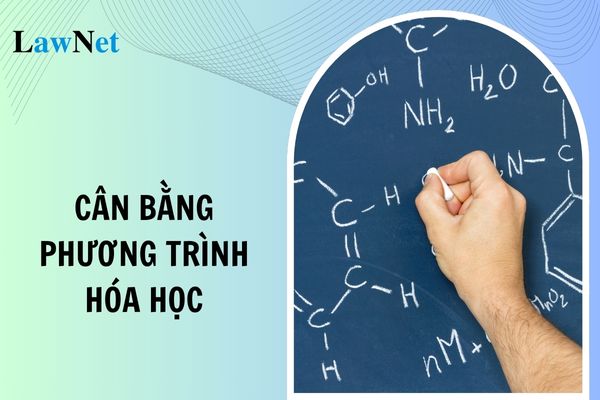Compilation of grade 8 chemical equation balancing exercises with answers in Vietnam
Compilation of grade 8 chemical equation balancing exercises with answers in Vietnam
Chemical equations are one of the topics students learn in the Grade 8 Natural Science subject. Balancing chemical equations is an essential part of this topic.
Refer to the compiled balancing exercises for Grade 8 chemical equations below:
Type 1: Balancing simple chemical equations
| Balance the following equations: - Cu(NO3)2 + NaOH → Cu(OH)2 + NaNO3 - P + O2 → P2O5 - N2 + O2 → NO - NO + O2 → NO2 - NO2 + O2 + H2O → HNO Answers: - Cu(NO3)2 + 2NaOH → Cu(OH)2 + 2NaNO3 - 4P + 5O2 → 2P2O5 - N2 + O2 → 2NO - 2NO + O2 → 2NO2 - 4NO2 + O2 + 2H2O → 4HNO3 |
Type 2: Select coefficients and appropriate chemical formulas to fill in the blanks in the chemical equations
| a) Al2O3 + ? → ?AlCl3 + ?H2O b) H3PO4 + ?KOH → K3PO4 +? c) ?NaOH + CO2 → Na2CO3 + ? d) Mg + ?HCl → ? +?H2 e) ? H2 + O2 → ? f) P2O5 +? → ?H3PO4 g) CaO + ?HCl → CaCl2 + H2O h) CuSO4 + BaCl2 → BaSO4 + ? Balanced equation answers a) Al2O3 + 6HCl → 2AlCl3 + 3H2O b) H3PO4 + 3KOH → K3PO4 + 3H2O c) 2NaOH + CO2 → Na2CO3 + H2O d) Mg + 2HCl → MgCl2 + H2 e) 2H2 + O2 → 2H2O f) P2O5 + 3H2O → 2H3PO4 g) CaO + 2HCl → CaCl2 + H2O h) CuSO4 + BaCl2 → BaSO4 + CuCl2 |
Type 3: Advanced set up of atomic diagrams and determination of the number of molecules of each substance after the reaction
| a) Na + O2 → Na2O b) P2O5 + H2O → H3PO4 c) HgO → Hg + O2 d) Fe(OH)3 → Fe2O3 + H2O Answers a) 4Na + O2 → 2Na2O Ratio: number of Na atoms: number of O2 molecules: number of Na2O molecules = 4 : 1 : 2. b) P2O5 + 3H2O → 2H3PO4 Ratio: number of P2O5 molecules: number of H2O molecules: number of H3PO4 molecules = 1 : 3 : 2. c) 2HgO → 2Hg + O2 Ratio: number of HgO molecules: number of Hg atoms: number of O2 molecules = 2 : 2 : 1. d) 2Fe(OH)3 → Fe2O3 + 3H2O Ratio: number of Fe(OH)3 molecules: number of Fe2O3 molecules: number of H2O molecules = 2 : 1 : 3. |
Type 4: Advanced, balance the following hidden chemical equations
| a) FexOy + H2 → Fe + H2O b) FexOy + HCl → FeCl2y/x + H2O c) FexOy + H2SO4 → Fe2(SO4)2y/x + H2O d) M + H2SO4 → M2(SO4)n + SO2 + H2O đ) M + HNO3 → M(NO3)n + NO + H2O e) FexOy + H2SO4 → Fe2(SO4)2y/x + SO2 + H2O f) Fe3O4 + HNO3 → Fe(NO3)3 + NxOy + H2O Answers a) FexOy + yH2 → xFe + yH2O b) FexOy + 2yHCl → xFeCl2y/x + yH2O c) 2FexOy + 2yH2SO4 → xFe2(SO4)2y/x + 2yH2O d) 2M + 2nH2SO4 → M2(SO4)n + nSO2 + 2nH2O đ) M + 2nHNO3 → M(NO3)n + 2nNO + H2O e) (5x - 2y) Fe3O4 + (46x - 18y) HNO3 → 3(5x - 2y) Fe(NO3)3 + NxOy + (23x - 9y)H2O |
Note: The content of the compiled Grade 8 chemical equation balancing exercises is for reference only!

Compilation of grade 8 chemical equation balancing exercises with answers in Vietnam (Image from the Internet)
What are methods for developing general competencies in the Natural Science Subject in Vietnam?
Based on the Curriculum for the Natural Science Subject issued with Circular 32/2018/TT-BGDDT, the methods for developing general competencies in the Natural Science subject is as follows:
Autonomous Learning and Self-Study Competence
Through teaching organization methods, the Natural Science subject trains students in self-study methods, and self-exploration to acquire scientific knowledge. Autonomous learning and self-study competence are developed through practical activities, project work, designing experimental activities in the laboratory, in the field, especially in organizing nature exploration.
Communication and Collaboration Competence
Communication and collaboration competence are developed through activities such as observation, constructing scientific hypotheses, planning and conducting hypothesis verification, collecting and processing data, aggregating results, and presenting research findings. These skills are regularly practiced in teaching the subject's topics.
The Natural Science subject contributes to developing collaborative competence when students frequently carry out learning projects, practical, and group activities. During these activities, students work in groups, where each member performs different parts of the same task, exchange ideas, and share learning content.
Problem-Solving and Creative Competence
Problem-solving and creativity are distinctive activities in exploring the natural world. This competence is developed by organizing students to propose problems, state hypotheses, plan, and execute the exploration of various natural phenomena close to everyday life.
What are forms of assessment in the Natural Science Subject in Vietnam?
According to the Curriculum for the Natural Science Subject issued with Circular 32/2018/TT-BGDDT, various forms of assessment in the Natural Science subject include:
- Assessment through written exams: essays, objective multiple-choice tests, theses, reports, ...
- Oral assessment: oral questions, interviews, presentations, ...
- Observation assessment: observing attitudes and activities of students through practical lab work, group discussions, field trips, visits to scientific and production facilities, applying knowledge to practice, using tools like observation tables, checklists, study logs,...

